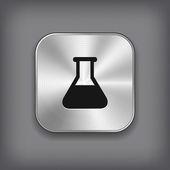This preliminary study focuses on the development of a medical image segmentation algorithm based on artificial intelligence for calculating bone growth in contact with metallic implants. %as a result of the problem of estimating the growth of new bone tissue due to artifacts. %the presence of various types of distortions and errors, known as artifacts. Two databases consisting of computerized microtomography images have been used throughout this work: 100 images for training and 196 images for testing. Both bone and implant tissue were manually segmented in the training data set. The type of network constructed follows the U-Net architecture, a convolutional neural network explicitly used for medical image segmentation. In terms of network accuracy, the model reached around 98\%. Once the prediction was obtained from the new data set (test set), the total number of pixels belonging to bone tissue was calculated. This volume is around 15\% of the volume estimated by conventional techniques, which are usually overestimated. This method has shown its good performance and results, although it has a wide margin for improvement, modifying various parameters of the networks or using larger databases to improve training.
翻译:初步研究的重点是根据人工智能来计算与金属植入物接触的骨骼生长量的医学图象分解算法的开发。%是估计由于人工制品造成的新骨骼组织生长量的问题造成的。%是各种扭曲和错误的存在,称为人工制品。在这项工作的整个过程中,使用了由计算机化微摄影图像组成的两个数据库:100张用于培训的图象和196张用于测试的图象。在培训数据集中,骨骼和植入组织都是人工分解的。所建造的网络类型遵循U-Net结构,即明确用于医学图象分解的进化神经网络。在网络精度方面,模型达到98 ⁇ 左右。一旦从新的数据集(测试组)获得预测,即计算出属于骨骼的象素总数。这一数量约为常规技术估计的总量的15 ⁇ 左右,通常被高估。这种方法显示了良好的性能和结果,尽管有很大的改进余地,可以修改网络的各种参数,或者使用更大的数据库来改进培训。





